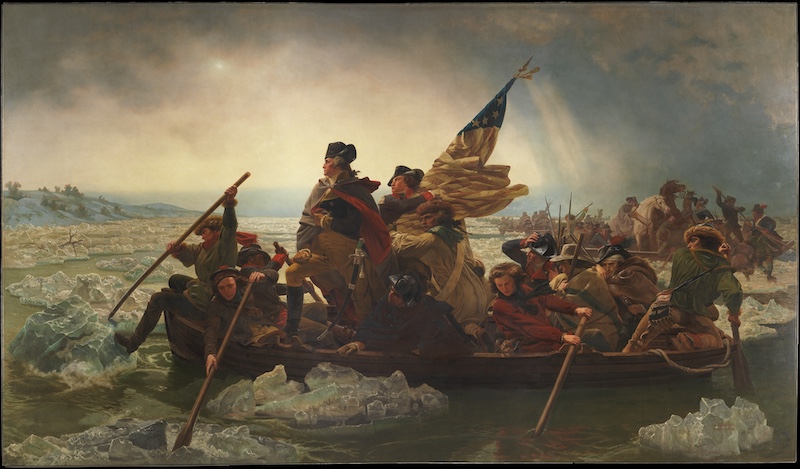Six Abolitionists in Photographs
See the portraits of antislavery advocates, including Frederick Douglass and Sojourner Truth, and learn how they used photography to advance their cause.
Art & Society
min read

Revolutionary War paintings are usually dramatic—think Washington Crossing the Delaware by Emanuel Leutze or The Death of General Wolfe by Benjamin West. You might not guess that a quiet portrait sets the stage for battles to come.

Emanuel Leutze, Washington Crossing the Delaware, 1851. Oil on canvas, The Metropolitan Museum of Art, Gift of John Stewart Kennedy (1897) 97.34.
In 1770 Charles Willson Peale painted Maryland attorney and farmer (and his close childhood friend) John Beale Bordley. The portrait argued Bordley’s case for why the American colonists deserved freedom from British rule.

Charles Willson Peale, John Beale Bordley, 1770, oil on canvas, Gift of The Barra Foundation, Inc., 1984.2.1
A Farmer who Sought Freedom
Bordley was a farmer who believed in American economic self-sufficiency. He brewed his own beer instead of drinking London ale. He grew wheat, a food staple, instead of tobacco, the cash crop that fueled Anglo-American trade. In his portrait, Peale includes other markers of Bordley's financial independence.
To his right in the portrait is a peach tree, one of the plants he successfully experimented with on his Wye Island farm.
To his right in the portrait is a peach tree, one of the plants he successfully experimented with on his Wye Island farm.
/
Bordley wears a brown homespun coat and waistcoat (vest). The fabric likely was made from the wool of Bordley’s own sheep.
/
We can see them in the background, grazing in a sunny pasture. Farming sheep reduced colonists’ dependence on imported British textiles.
/
Bordley wears his hair naturally dressed, not in a wig—as was the British fashion.
/
Every part of his appearance serves as a rebuke to British imperialism.
/
The Letter of the Law
Why is Bordley so staunch in his opposition to British rule? Peale lays clues throughout the painting.
Follow Bordley’s finger, which points toward the statue of a woman.
Follow Bordley’s finger, which points toward the statue of a woman.
/
She is the symbol of liberty.
/
In her left hand, she carries a staff topped with a Phrygian cap—also known as the liberty cap.
/
In her right, she holds the scales of justice.
/
She stands on a pedestal inscribed with the phrase “Lex Angli,” Latin for “English law.”
/
In a portrait of someone so opposed to British rule, this inscription may seem mysterious. What could “English law” refer to?
/
In the lower left, a torn document reads, “Imperial Civil Law — Summary proceeding.”
/
This likely refers to a new rule for collecting customs duties (taxes) after 1763. The paper is ripped in two as a rejection of the new law.
/
Bordley rests his left arm on an open book. The text reads “Nolumus Leges Angliae mutari,” Latin for, “We do not wish the laws of England to be changed.”
/
Viewers of the time would have recognized this as the answer King Charles I of England gave to the Nineteen Propositions. Passed by the English parliament in 1642, the propositions asked that the monarch share more power with the two parliamentary houses. King Charles I rejecting these demands plunged the country into the English Civil War. The phrase came to refer to the dangers of changing the English constitution.
In Peale’s portrait, Bordley builds his case like a lawyer. The inscriptions weave together a network of meaning, underlining the hypocrisy of British governors levying new taxes on American colonists. These taxes contradicted the spirit of Lex Angli—the English constitution, which stood for justice and liberty. True British citizens would never endure such tyranny from their rulers.
More Symbols of Injustice
Peale painted more scenes and symbols of indignities suffered at the hands of the British at the edges of the painting.
To Bordley’s left, we spot a small distant figure. By his red coat and black cocked hat, we can identify him as a British soldier.
To Bordley’s left, we spot a small distant figure. By his red coat and black cocked hat, we can identify him as a British soldier.
/
The British army collected the fees owed to colonial officials. Here, the redcoat walks behind a pack animal loaded with sacks, carrying away the fruits of colonists’ labors.
/
Peale carefully painted a jimsonweed growing in front of the statue’s pedestal.
/
The weed, which had a distinctive thorn apple and a trumpet-shaped flower, is a natural hallucinogen.
/
British soldiers sent to Jamestown in 1676 to quell Bacon’s Rebellion were said to have become delirious after eating the plant. As a result, it became associated with British tyranny.
/
How did these two men know each other?
Behind the revolutionary meanings of this portrait also lies a story of friendship. Peale’s father had served as Bordley’s tutor, and Peale was his close childhood friend. As an adult, Bordley raised funds to send Peale to London to study with acclaimed painter Benjamin West. When Peale returned, Bordley helped him get his first major commission in the American colonies—two life-size portraits, including this painting.
Peale shared Bordley’s strong belief in colonial independence. During the Revolutionary War, Peale served with the Pennsylvania militia against the British. He carried his miniature case to paint portraits of fellow officers.
Together, Peale and Bordley supported each other's careers and fought for American independence. They are immortalized in Charles B. J. Févret de Saint-Mémin’s engraved portraits.

Charles B. J. Févret de Saint-Mémin, John Beale Bordley, 1802-1803, mezzotint and engraving in black on wove paper mounted to brown wove paper, Corcoran Collection (Gift of William Wilson Corcoran), 2015.19.1584.37.3

Charles B. J. Févret de Saint-Mémin, Charles Willson Peale, 1807, mezzotint and engraving in black on wove paper mounted to brown wove paper, Corcoran Collection (Gift of William Wilson Corcoran), 2015.19.1584.37.2